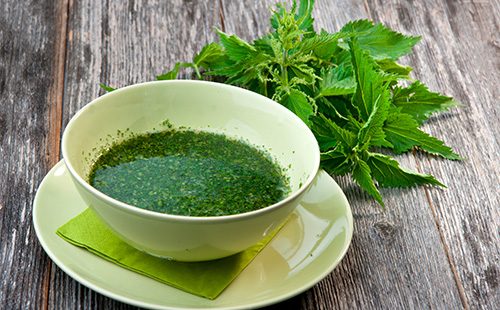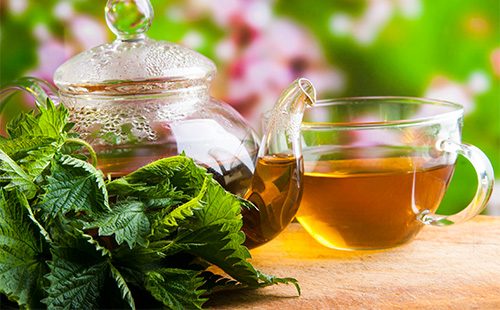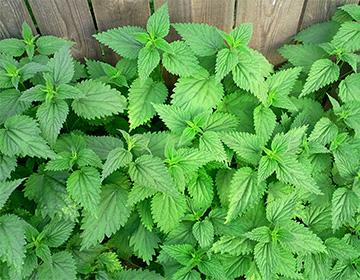The content of the article
The uniqueness of the plant is given by the extreme strength of the fibers, which along with flax and cotton were used for the production of fabrics. Rough, technical fabrics were produced from nettles in Russia, but in China they were used to spin thin, delicate materials similar in characteristics to silk. By the way, some elements of national costumes in the Middle Kingdom are still being produced from this plant material. In Russia, culture was no longer used for technical purposes in the 20th century.
Botanical characteristic
The raw materials obtained from stinging nettle, popularly called a lighter, dragonfly, stinging, have pharmacological value. The Latin name Urtica dioica is associated with the term urere, which means “burn”.
The main feature of a plant that can leave burns on the skin of people and animals is attached to thorns located everywhere on stems and petals. In shape they resemble medical ampoules, inside filled with a composition of silicon salts, formic acid and histamine. They are extremely brittle, their head is extremely sharp. When it touches the skin, it bites into the tissue and breaks off, releasing the contents. Causes swelling, redness, and a burning sensation. For the body, such a “burn” is absolutely harmless, the danger is only in the case of an individual allergic reaction.
Description
Nettle plant is a perennial grass with a powerful stem and well-developed root system. The rhizome is long, branched, creeping, with cord-shaped processes that can significantly deepen into the soil. Stems erect, 60 to 170 cm high, tetrahedral. They branch extremely rarely, directed towards the sun, often planted with leaves located opposite.
Leaves are dark green, large (reach 18 cm in length and 8 cm in width), elongated, with a pointed apex. The base is heart-shaped or rounded, curved teeth are scattered along the edge. The entire surface of the stems and leaves looks shaggy, felt, as it is covered with tiny hairs and needles.
The culture blooms from June to September, but the plant does not become noticeable at this time. The flowers are small, greenish, gather in the upper part of the stem in bunches or spikelets emerging from the upper leaves. Bees do not pollinate flowers; pollen is spread by the wind. Seeds - nuts of an elliptical shape and up to 1.5 mm in size - ripen by September.
A medicinal plant is found throughout Russia, except in the Far North.It prefers well-moistened soils, therefore it settles on the banks of rivers, lakes, reservoirs, in lowlands.
Collection and harvesting of raw materials
Pharmacopoeial raw materials are the leaves of a plant that are harvested during the flowering period. They carry out the collection with gloves or mow the stems whole with a tool, and then leave them to dry. Dried leaves and stems lose their stinginess, then you can work with them with your bare hands.
Leafs are torn off at the very base of the plate, dried simply in the open air or in a room with good ventilation. The finished raw material is a dark green dry nettle leaf, brittle, with noticeable rare light hairs on the surface. It is stored in linen bags for two years.
The roots of the plant in Russia are not recognized as medicinal raw materials, and their preparation by the pharmacological industry is not carried out. However, in Europe it is rhizomes that are used for therapeutic purposes, and herbalists have traditionally used them to treat diseases in men. They dig up rhizomes in the fall, clean them from the ground, and wash them. Dry in the attics and under the awnings. Store up to three years.
Composition and properties
Phytotherapist, author of books on medicinal herbs N. I. Maznev called dioecious nettle a useful plant, “a source of health”. This characteristic is due to the valuable composition of the culture, which includes:
- urticin glycoside;
- chlorophyll (up to 5%);
- tannins (more than 2%);
- formic and pantothenic acids;
- flavonoids;
- nicotine;
- coumarins.
Young grass is a multivitamin plant; fresh leaves contain:
- ascorbic acid (vitamin C);
- phylloquinone (vitamin K);
- carotenoids (vitamin A).
Key effects
The analysis of the composition of the medicinal plant is the work of modern researchers. So in 2006, specialists of the Kursk State Medical University studied the biologically active substances of culture, which allowed us to expand our understanding of the benefits of nettle. The composition revealed:
- amino acids;
- water soluble polysaccharides;
- pectin substances;
- tripertin compounds and saponins;
- minerals (potassium, calcium, magnesium, sodium, phosphorus, iron and others).
It was established that the content of biologically active substances of the plant does not depend on the region of its growth. Therefore, for therapeutic purposes, you can equally effectively use pharmacy raw materials, and harvested personally in the country.
Dried nettle has five properties:
- bactericidal;
- wound healing;
- diuretic;
- choleretic;
- blood purifying.
There is also a sixth pronounced effect - the plant stimulates hair growth.
Therapeutic practice
In modern therapeutic practice, various aspects of the impact of the bioactive complex of culture on the human body are considered. And it is extremely multifaceted.
Travnik A.Varennikov notes the ability of the plant to restore the function of hematopoiesis of the bone marrow and increase the hemoglobin in the blood no worse than iron preparations. Experimentally proven sugar-lowering effect. This can contribute to weight loss in overweight people, if the fullness is caused by metabolic disorders and there is a risk of developing type 2 diabetes.
Gynecology
In gynecological practice, liquid nettle extract is used. The tool is indicated for:
- puberty, menopause;
- subserous fibromyomas;
- delayed uterine involution after abortion, childbirth.
Prescribe the drug in a dosage of 30-40 drops per reception four times a day. Reinforced, accelerated contractile activity of the uterus while taking the extract. In adolescence, it is given to girls in the same dosage. The most important advantage is that it can stop bleeding against the background of a normal menstrual cycle. Plus exhibits anti-inflammatory activity. The drug is prescribed for uterine fibroma, parametritis, salpingo-oophoritis, metroendometritis.
Urology
In European medicine, dosage forms from the roots of culture are used for the symptomatic treatment of urinary disorders in men due to benign prostatic hyperplasia. With prostatitis, accompanied by urinary retention, frequent and ineffective urge to the toilet, drink a nettle broth for two reasons.
- Affects sex hormone binding globulin. In the body of men there is a plasma protein globulin, responsible for maintaining a certain concentration in the blood of the hormones of androgens and estrogens. The cell membrane of the prostate gland responds to hormone levels through cell recipes located in its structure. A change in the hormonal background causes an enlargement of the gland in size, which causes unpleasant side effects. During the experiments of European scientists it was found that the biologically active substances of the plant reduce the binding activity of globulin, thereby stopping the process of enlargement of the prostate.
- Reduces prostate volume. In the experiment of the German specialist G. Daube, conducted in 1988, the direct effect of the water-alcohol extract of dioica nettle on the size of the prostate of dogs was revealed. After 100 days of daily use of the drug, a significant decrease in organ volume by 30% was recorded. (The selected dosage is 30 mg of the drug per 1 kg of animal weight).
Bleeding tendency
The risk of bleeding exists with insufficient blood coagulation, with hemorrhoids, in menopausal women, with varicose veins. In these cases, freshly picked grass is useful. Its juice is taken orally (a teaspoon four to five times a day), and the pulp is used externally, applied to bleeding wounds. Due to the high content of vitamin K, the composition eliminates internal bleeding, effectively reduces blood loss.
Contraindications
In folk medicine, there is no mention of contraindications to a medicinal plant. However, it is impossible to consider culture absolutely safe. The World Health Organization does not recommend taking nettles during pregnancy and lactation due to its hormone-like effect. Also, the effect of the active substances that bind androgens and estrogens on the hormonal background of children is not known.The plant is not used for individual intolerance.
Prescription Drugs
Traditional medicine offers many recipes for the use of dioica nettle. Especially interesting are the traditional techniques where the plant is used in collections. Herbalists believe that it is safer to use the culture in combination with other plants.
Blood Purifying Steam
Features. With frequent occurrences of acne, boils, rashes, itchy areas on the body, blood cleansing is recommended. Use dried leaves of the culture in the form of steam.
How to make and apply
- Pour 50-60 g of dry leaf into a container.
- Pour boiling water with a volume of 1 liter.
- Leave to infuse for 30 minutes.
- Strain.
- Take a glass a couple of times three times a day.

Blood purifying mixture
Features. Another recipe is given by the classic of Russian herbal medicine M. Nosal. In it, the blood-purifying properties of the described plant are complemented by the action of dandelion leaves and blackthorn flowers.
How to make and apply
- Combine an equal amount of dried ingredients.
- Take two tablespoons of the mixture.
- Pour two glasses of boiling water.
- Cover, put in the oven to simmer for two hours.
- Drink the resulting infusion during the day, and the next day - prepare a new one. Take it for two weeks, excluding eggs, meat, fish, vodka, beer from the diet. Milk nutrition is recommended.
Composition for baldness
Features. The tool stops hair loss, reduces the oily scalp, eliminates seborrhea. But with dry skin it dries even more, so be careful.
How to make and apply
- Take 100 g of dried leaf.
- Grind, fill with water with a volume of 250 ml.
- Add 250 ml vinegar.
- Put on a small fire, bring to a boil.
- Boil for 30 minutes.
- Rinse your head with shampoo after using the mixture. Apply it to the roots, carefully distribute it on the scalp, then along the entire length of the hair. Do not flush.
Universal infusion
Features. Means of wide application. It is intended for oral administration in inflammatory diseases of the gastrointestinal tract, anemia, hemorrhoids, liver and kidney diseases. Topically used to enhance hair growth, against dandruff. Baths with nettles brewed according to this recipe are prescribed for rheumatism, gout, multiple skin lesions, for bathing children with diaper dermatitis.
How to make and apply
- Pour two tablespoons of chopped leaves into a container.
- Pour boiling water with a volume of 250 ml.
- Leave to brew for 40 minutes.
- Strain.
- Take two tablespoons by mouth four to six times a day. Rub into the scalp once or twice a week after washing your hair.
Decoction of seeds for cough and insomnia
Features. The composition of the seeds has not been studied and they are not used in pharmacology. But in folk medicine they are used for nightly suffocating paroxysmal cough (without sputum discharge) and insomnia.
How to make and apply
- Pour 25 g of seeds into an enameled container.
- Pour boiling water with a volume of 250 ml.
- Put on fire, bring to a boil.
- Stew under the lid for ten minutes.
- Remove from heat, leave to brew for one hour.
- Strain.
- Take at night. To improve the taste, add sugar or honey.
A decoction of the roots for men
Features. This is a tool for the treatment of "male" diseases associated with enlargement of the prostate gland. A decoction for gastritis, colitis, anemia, cough is also useful. It has a pronounced blood-purifying effect in case of furunculosis, rashes, acne, allergic urticaria.
How to make and apply
- Melt sugar with water (200 ml) until syrup is obtained.
- Add 20 g of chopped rhizomes.
- Boil for 15 minutes.
- Take a tablespoon five to six times a day.

Multifunctional tincture on vodka
Features. The medicine is prepared from dry raw materials. Used to treat diseases of the stomach, intestines, kidneys, liver, prostate, cough, furunculosis, thrombophlebitis.
How to make and apply
- Pour two tablespoons of the raw material into a glass container.
- Pour alcohol or strong vodka with a volume of 500 ml.
- Leave to infuse in a dark place for two weeks.
- Strain.
- Take a tablespoon three times a day 30 minutes before meals.
According to herbalists, the plant has a general healing effect, improves the functioning of the heart, liver, kidneys, intestines and stomach. Therefore, in Russia it was often consumed fresh, adding to salads or cabbage soup. The medicinal properties of dioica nettle are mentioned in the first Russian manuscript herbalist of the XVIII century.

